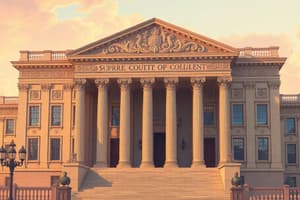Podcast
Questions and Answers
What is the primary purpose of criminal law?
What is the primary purpose of criminal law?
- To ensure fair trials in civil cases
- To resolve disputes between individuals
- To provide a framework for government operations
- To punish harmful behavior against society (correct)
What distinguishes civil law from criminal law?
What distinguishes civil law from criminal law?
- Civil law incurs penalties, while criminal law requires compensation.
- Civil law involves personal disputes, while criminal law involves state prosecution. (correct)
- Civil law is the domain of judges, while criminal law is run by juries.
- Civil law deals with individuals, while criminal law deals with the government.
What is meant by original jurisdiction in the context of court systems?
What is meant by original jurisdiction in the context of court systems?
- The ability to create new laws
- The authority to hear appeals from lower courts
- The right to conduct trials in the first instance (correct)
- The power to review decisions made by legislative bodies
Which court has the authority to review the decisions of lower courts?
Which court has the authority to review the decisions of lower courts?
What distinguishes Judicial Restraint from Judicial Activism?
What distinguishes Judicial Restraint from Judicial Activism?
Which body confirms judges nominated by the President?
Which body confirms judges nominated by the President?
Which type of jurisdiction allows a case to be heard in more than one type of court?
Which type of jurisdiction allows a case to be heard in more than one type of court?
What establishes the authority of Congress to create Inferior Courts?
What establishes the authority of Congress to create Inferior Courts?
For how long are judges of Constitutional Courts appointed?
For how long are judges of Constitutional Courts appointed?
Flashcards
U.S. Court of Appeals function
U.S. Court of Appeals function
Reviews decisions of lower courts to ensure they followed proper procedures.
Legislative court example
Legislative court example
A court created by Congress for a specific purpose, not outlined in the Constitution.
Highest U.S. court
Highest U.S. court
The Supreme Court, the final authority on legal interpretations.
Appealing to Supreme Court first step
Appealing to Supreme Court first step
Signup and view all the flashcards
Article 3 courts
Article 3 courts
Signup and view all the flashcards
Supreme Court case acceptance reason
Supreme Court case acceptance reason
Signup and view all the flashcards
Appellate court decision, no error
Appellate court decision, no error
Signup and view all the flashcards
Criminal law purpose
Criminal law purpose
Signup and view all the flashcards
Concurrent jurisdiction
Concurrent jurisdiction
Signup and view all the flashcards
Court reviewing lower courts
Court reviewing lower courts
Signup and view all the flashcards
Study Notes
U.S. Court System
- Court of Appeals: Primarily a reviewing court, not a trial court.
- Legislative Court: Example of a legislative court is not provided.
- Supreme Court: Highest court, final appeals destination.
- Appeals Process: First step in appealing to the Supreme Court is not detailed.
- Article III Courts: Courts established by Article III of the Constitution.
- Supreme Court Case Acceptance: Typical reason for the Supreme Court to hear a case is not provided.
- Appeals Decision: If an appellate court finds no error in the lower court's decision, the lower court decision is upheld.
- Criminal Law Purpose: The primary purpose of criminal law is not articulated.
- Concurrent Jurisdiction: Allows a case to be heard in more than one type of court.
- Appellate Jurisdiction: The authority of a court to review decisions of lower courts; the Supreme Court has this.
- Civil vs. Criminal Law Distinction: The distinction between civil and criminal law is not described.
- Highest Court: The highest court in the U.S. judicial system is the Supreme Court.
- Trial Courts: Conduct trials involving a judge or jury.
- Original Jurisdiction: The court system's original jurisdiction is not defined.
- Intermediate Appellate Court: Court standing between trial courts and the state's highest court is not detailed.
Federal Courts
- Exclusive Jurisdiction: Allowing a court to have sole authority to hear a case.
- Non-Judicial Branch Hearing: The Judicial Branch does not hear a specific case not mentioned.
- Congressional Power: Congress establishes the authority to create inferior courts.
- Constitutional Courts: Primary role is to uphold and interpret the Constitution.
- Judge Removal: How judges in Constitutional Courts can be removed is not provided.
- Federal Courts Purpose: Purpose of the U.S. Court of Federal Claims is not articulated.
- Courts of Appeals: Key distinction between the U.S. Court of Appeals for Veterans Claims and other courts is not provided.
- Legislative Courts: The type of courts established by Congress is not fully described.
- Military Commissions: A statement on military commissions is not provided.
- Judicial Appointments: Who nominates judges for federal courts, the length of appointment, and attorney responsibilities are not fully detailed.
- Confirmation Process: Body confirming judges nominated by the President is not detailed.
- U.S. Marshals: One task of the U.S. Marshals that is not a responsibility of the U.S. Marshals is not described..
Judicial Review and Interpretation
- Judicial Activism: Meaning of the Judicial Activism is not detailed.
- Congressional Role: What Congress sets for federal is not provided.
- Trial Procedure: The explanation of what judges explain to the jury is not defined.
- Supreme Court Criteria: The cases Supreme Court looks for when choosing which cases to hear; criteria are explained by significance, conflicts, and importance.
- Writ of Certiorari: Order from the Supreme Court to review a lower court's decision.
- U.S. Solicitor General: The job of the U.S. Solicitor General is to represent the United States in Supreme Court cases.
- Rule of Four: Justices required for agreeing to hear a Supreme Court case.
- Legal Questions vs. Evidence: Supreme Court hearings concentrate on legal questions.
- Oral Arguments: Each side presents its legal arguments.
- Judicial Enforcement: The method by which the Supreme Court's decisions are enforced.
- Judicial Philosophy: Judicial Restraint vs Judicial Activism; Judicial Restraint is when justices limit the powers of the courts to interpret the Constitution. Judicial Activism is defined as justices who believe in limiting the powers of the courts to interpret the Constitution.
- Public Opinion: Public opinion can sway Supreme Court decisions.
- Living Constitution: The interpretation of the Constitution changes with changing times.
Studying That Suits You
Use AI to generate personalized quizzes and flashcards to suit your learning preferences.




